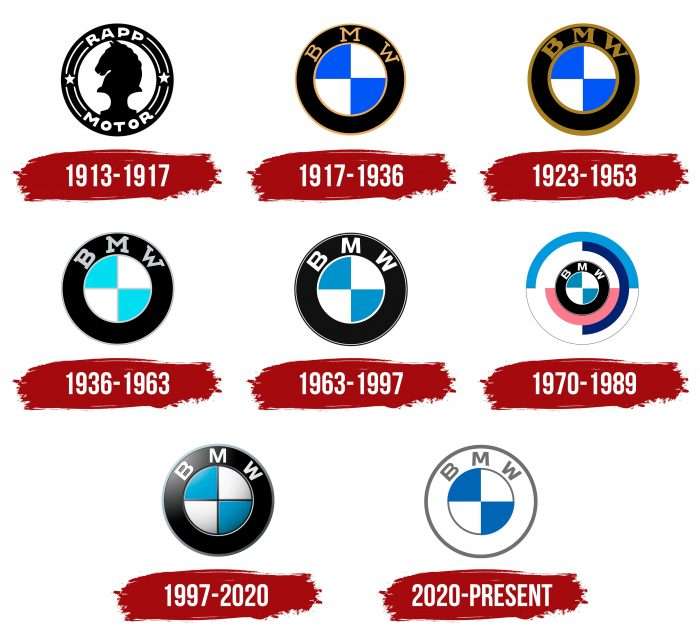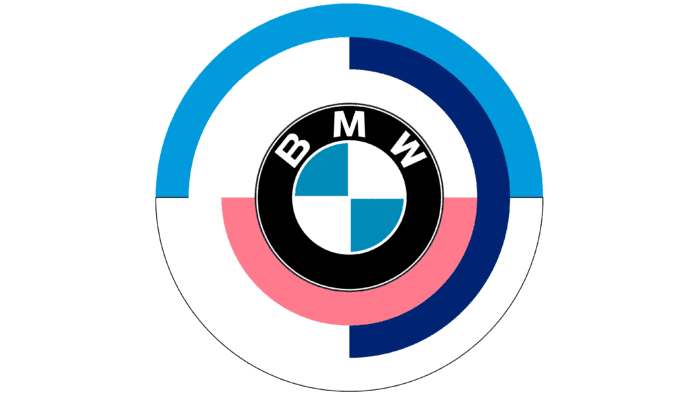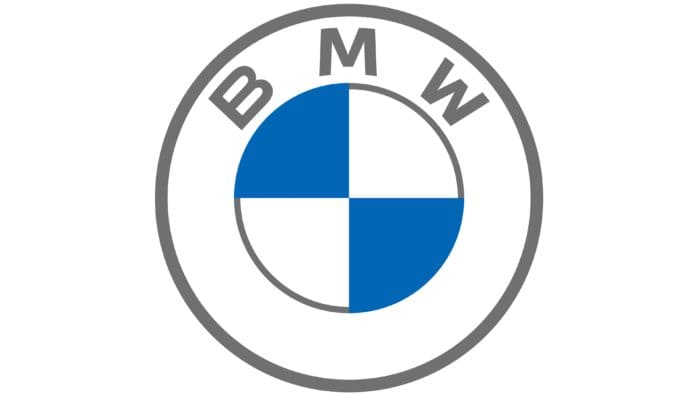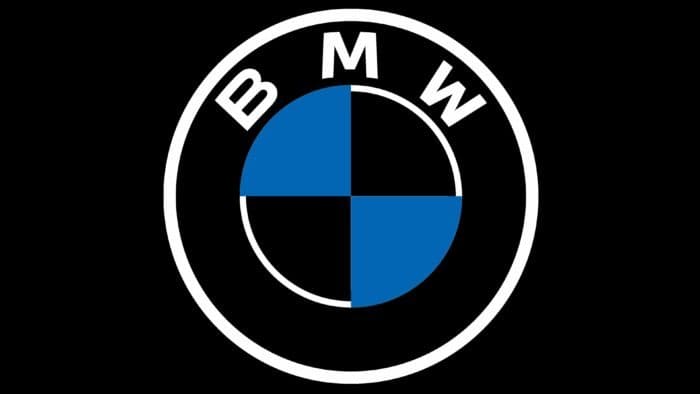The famous car manufacturer, the BMW emblem, illustrates the importance of connections between the past and present. The emblem symbolizes a commitment to historical values, a drive to use modern technologies, reliability, and technical prowess.
BMW: Brand overview
BMW stands for Bayerische Motoren Werke AG. It is a globally renowned manufacturer of cars, quad bikes, motorcycles, and engines, holding leading positions in the industry. The company is located in Munich, Bavaria, Germany, and was founded in March 1916. Its founders are Franz Josef Popp, Camillo Castiglioni, and Karl Rapp.
Meaning and History
The BMW emblem graces the hoods of all the brand’s cars, signifying the high status of their owners. It is an exceptional symbol that perfectly complements the slogan “Freude am Fahren,” which translates from German to “The Joy of Driving.”
The German company’s product range included aviation engines, which directly influenced the logo. The debut version consisted of a circle divided into four equal sectors of blue and white colors, a black border, and the inscription “BMW.” It was an airplane propeller against the backdrop of the blue sky.
However, after World War I, Germany was prohibited from producing airplanes, so the plant requalified and began to produce agricultural equipment and brakes for trains. Finally, in 1923, the debut of a motorcycle with a blue-and-white BMW logo marked a new era for the brand.
Five years later, the company purchased a car factory in Eisenach and launched the production of its first car named Dixi. By the mid-1930s, BMW had transformed into a massive industrial conglomerate in Bavaria, and the corporation became the largest industrial consortium in Europe. Its logo was considered a sign of prestige and high status.
What is BMW?
BMW is an acronym for Bayerische Motoren Werke AG and one of its brands, alongside Rolls-Royce and Mini. The German automotive company was founded in 1916 and began as an aviation engine manufacturer. It released its first car in 1928.
1913 – 1917
RAPP Motorenwerke is the company that would eventually become the modern automotive giant. The company’s logo features a symbol of a horse enclosed in a circle.
1917 – 1936
The debut version’s logo was based on the badge passed down from BMW’s predecessor, RAPP. It featured a circle with a horse in the center, surrounded by a wide band with the company’s name inscribed. The text’s placement and font remained the same as in the prototype. However, the horse image disappeared – in its place appeared improvised airplane propellers in the colors of the Bavarian flag.
Moreover, the brand’s symbolism, confirming good design, remained forever. Over many years, the company’s logo remained virtually unchanged. Only minor adjustments were made to the font and variations of the blue shade.
1923 – 1953
During this period, the first major redesign of the logo was conducted. Each element gained a dark golden border. In addition, the blue color became rich, and the font became wide and bold.
1936 – 1963
In 1936, designers replaced the thick border lines with thin white lines, visually lightening the logo. They also used sky blue instead of blue and reinterpreted the color of the abbreviation, making it a contrasting light on a dark background.
1963 – 1997
The logo acquired a different font and almost a cobalt shade.
1970 – 1989
During this period, BMW, which was involved in racing sports, used a different logo to separate sports from the company’s main activities.
1997 – 2020
This period is characterized by the emergence of a convex volumetric center and a metallic shine on the black ring trim. The 3D effect was achieved through thin lines in the center, glowing at the letter “B.”
2020 – today
The modern version has undergone the most significant changes. Instead of a wide black band, now a light-silver one is depicted. The volumetric element disappeared. A thin edging runs around the ring. The blue color was reinforced again.
BMW: Interesting Facts
BMW is a big company from Germany that makes fancy cars and motorcycles.
- Planes First: BMW didn’t start with cars or bikes; it made airplane engines during World War I. The BMW logo looks like a propeller spinning in the sky, but people don’t all agree that’s what it means.
- Motorcycles Came Next: BMW made its first motorcycle in 1923, called the R32. It had a special engine and design that BMW still uses in bikes today.
- The Kidney Grille: BMW cars have a special grille on the front that looks like kidneys. This design started in 1933 and is still on BMW cars, making them easy to spot.
- First BMW Car: The first car with a BMW badge was called the Dixi 3/15, which came out after BMW bought another company in 1928. It was a tiny car that helped BMW get into making cars.
- Art Cars: Since 1975, BMW has asked famous artists to paint some cars, turning them into moving art pieces. Some of these cars are famous and collectible.
- Famous BMW Cars: BMW has made some important cars, like the BMW 2002, a sporty little sedan, and the BMW M1, a fast car meant for racing.
- Caring for the Planet: BMW’s BMW i brand aims to make better cars for the environment. This includes cars running on electricity or hybrids using gas and electric power.
- Big Family: BMW owns MINI and Rolls-Royce, making small, fun cars and fancy, expensive cars, too.
- Racing Around: BMW loves racing and has won many big races with its fast cars. It has a special part of the company called BMW M that makes its regular cars go fast.
- All Over the World: BMW makes cars in many countries, not just Germany. This means people everywhere can buy a BMW.
BMW is known for making cars and motorcycles that are nice to look at, fun to drive, and even good for the planet—people who like fancy things and work well, like BMW.
Font and Colors
The current BMW logo is considered one of the most successful in the automotive industry, so it has not undergone significant changes. The evolution only touched on minor details. The graphic symbol has always consisted of a dark circle with the company’s abbreviated name. Initially, the core was divided into four equal fragments with alternating color sectors.
The brand’s palette also has barely changed, remaining within the national colors of Bavaria. Black embodies elegance and classicism, white symbolizes purity and attractiveness, blue signifies reliability and technical prowess, and silver represents a connection with metal and metallic products.
The font used in the current version appeared in 1953, although it was without serifs. But ten years later, serifs were removed, and Helvetica Black Condensed – a strict, smooth font that fits perfectly into the automotive industry- was chosen.
BMW color codes
| Nickel | Hex color: | #707070 |
|---|---|---|
| RGB: | 112 112 112 | |
| CMYK: | 0 0 0 56 | |
| Pantone: | PMS 424 C |
| Medium Persian Blue | Hex color: | #0066b5 |
|---|---|---|
| RGB: | 227 212 173 | |
| CMYK: | 0 4 20 7 | |
| Pantone: | PMS 285 C |
FAQ
What is the hidden meaning of the BMW logo?
The round shield with multicolored triangles represents the Free State of Bavaria flag, although it features diamonds rather than triangles. However, the color palette fully corresponds: designers combined white and azure colors.
What does the BMW logo symbolize?
The belief that the BMW logo symbolizes a propeller does not match reality. It was created after the flag and coat of arms of the Free State of Bavaria, but since the law prohibited the use of state symbols as emblems, designers had to depict a set of abstract figures on the shield while preserving the white-azure color scheme.
What is the current symbol of BMW cars?
Currently, the automotive brand BMW has a rondel logo. It consists of a central circle with four connected triangles: two white and two azure. And in the ring, formed by part of the large outer circle, is written the manufacturer’s name. All contours and letters are grey; the base is white.













